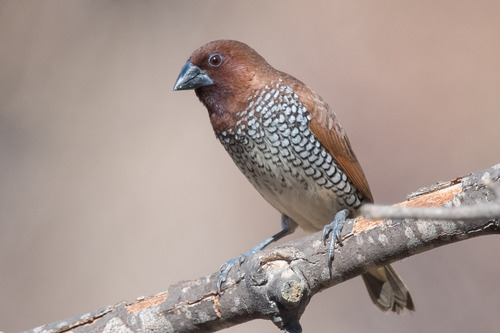
Scaly-breasted Munia
The Scaly-breasted Munia (*Lonchura punctulata*) is a small, gregarious bird belonging to the finch family. It is native to tropical Asia, but its popularity in the pet trade has led to established feral populations worldwide. Known for its distinctive scale-like markings on the breast and flanks, this species plays a role in seed dispersal within its ecosystem. While not globally threatened, localized habitat loss can impact populations. It holds no major specific cultural significance other than being a commonly kept cage bird in some regions.
11-12 cm
Length
14-15 cm
Wingspan
Least Concern
Conservation Status
Distribution
Native to South and Southeast Asia, including India, Sri Lanka, southern China, Taiwan, the Philippines, and extending through the Indonesian archipelago. Introduced and established in parts of Australia, the Caribbean (Puerto Rico, Jamaica), and the United States (primarily Hawaii and parts of California and Florida).
Lifespan
Typically 4-6 years in the wild, up to 8 years in captivity.
Scaly-breasted Munia's Habitat
Habitat Types
Grasslands, Open Woodlands, Cultivated Fields (especially rice paddies), Gardens and Parks, Scrublands
Climate Zones
Tropical, Subtropical
Adaptations
Highly adaptable to human-modified landscapes, thriving in agricultural areas and urban environments. Their strong, conical beaks are well-suited for cracking grass seeds, their primary food source.
Variations
Numerous subspecies (around 11-12) are recognized, differing subtly in plumage coloration and size across their vast range. For example, *L. p. punctulata* is the nominate subspecies found in India, while *L. p. nisoria* is found in parts of Indonesia.
Appearance
Breeding Plumage
No significant difference between breeding and non-breeding plumage.
Seasonal Feather Changes
Minimal seasonal variation.
Sex Based Plumage Differences
Sexes are visually similar; males and females have the same plumage.
Notable Features
Chestnut-brown upperparts., White underparts with distinctive black scale-like markings on the breast and flanks., Dark conical bill., Juveniles are paler brown above and buff below, lacking the scaly pattern.
Diet and Feeding
Primary Foods
Grass Seeds, Small Rice Grains, Small Berries (occasionally), Small Insects (especially during breeding season)
Foraging Behavior
Forages primarily on the ground, often in large flocks. They hop and peck at fallen seeds. They also cling to grass stems to extract seeds directly from seed heads.
Specializations
Their strong, conical bill is perfectly adapted for cracking the husks of grass seeds.
Seasonal Diet Variations
Diet primarily consists of grass seeds year-round, but the specific types of seeds consumed may vary depending on seasonal availability. During the breeding season, they may consume more insects to provide protein for growing chicks.
Behavior
Social Structure
Highly social, often found in flocks of 10-50 birds, sometimes even hundreds. They are generally non-territorial outside of the immediate nesting area.
Communication
Soft 'chit-chit' contact calls within flocks., A wheezing, buzzing song used during courtship., Alarm calls when predators are detected.
Migration
Generally non-migratory, but may undertake local movements in response to food availability or rainfall.
Territorial or Group Behaviors
Forms large communal roosts at night, often in dense vegetation. While not strongly territorial, they will defend the immediate area around their nest during breeding.
Conservation
Threats
Habitat Loss (due to agricultural intensification and urbanization), Pesticide Use (indirectly affecting food sources), Trapping for the Pet Trade (although less significant than for some other finch species)
Protection Programs
None specifically targeted at this species, but benefits from general habitat conservation efforts.
Local National Laws
Protected under general wildlife laws in many countries, prohibiting trapping or hunting without permits.
Population Trend
Stable
Population Estimates
The global population is extremely large and not precisely quantified, but is estimated to be in the millions.
Interesting Facts
They are also known as the Spice Finch.
This name refers to the spice islands of Indonesia, part of their native range, and perhaps alludes to their brown coloration.
Feral populations have become established far outside their native range.
Escaped cage birds have successfully colonized areas like the Caribbean and parts of the United States.
They are highly adaptable to human-modified environments.
They thrive in agricultural areas and even urban parks, as long as there is a sufficient supply of grass seeds.
They build surprisingly large nests.
For such a small bird, their domed nests are relatively large and robust.
Faqs about Scaly-breasted Munia
Are Scaly-breasted Munias good pets?
They can be relatively easy to care for, but they are social birds and should be kept in pairs or small groups. They are not known for being particularly interactive with humans.
What do Scaly-breasted Munias eat?
Their primary diet consists of grass seeds. They also eat small berries and insects, especially during the breeding season.
Are Scaly-breasted Munias invasive?
While they have established feral populations outside their native range, they are not generally considered highly invasive. Their impact on native ecosystems is usually minimal.
How can I tell the difference between a male and a female Scaly-breasted Munia?
It is very difficult to distinguish between the sexes visually. Both males and females have the same plumage. Subtle differences in song and behavior during courtship are the most reliable indicators, but even these are not always obvious.
Copyright @ Nature Style Limited. All Rights Reserved.
 English
English